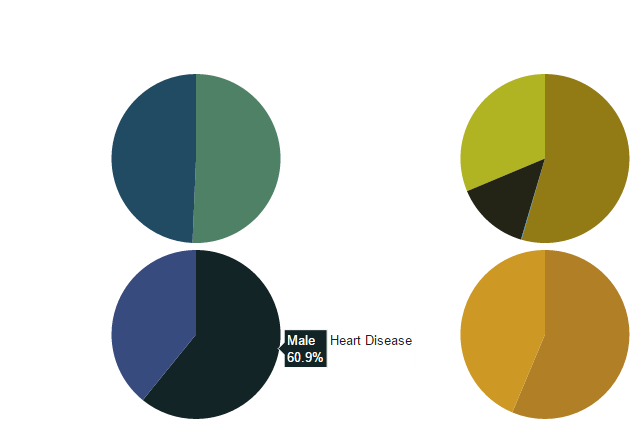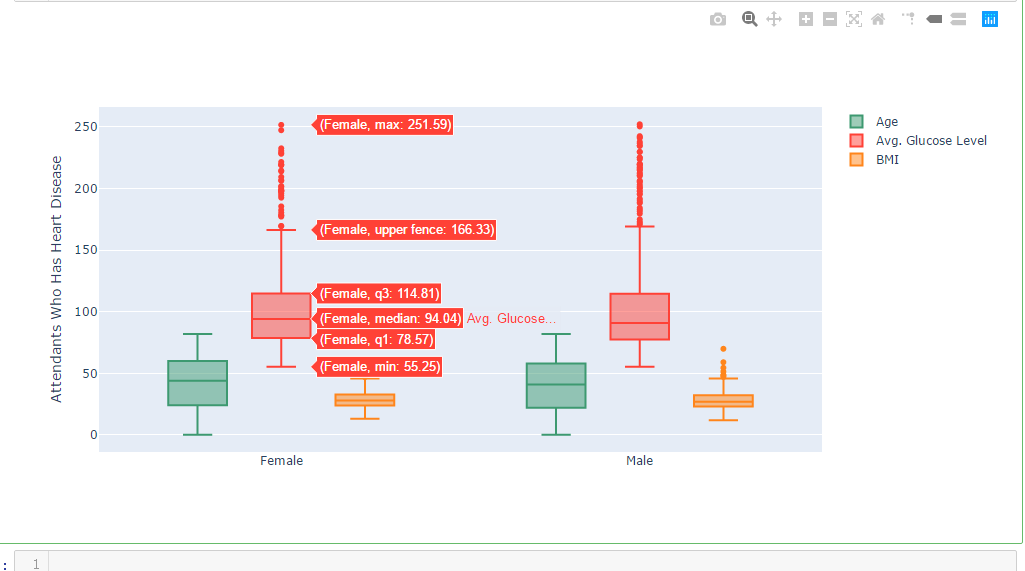
import numpy as np # linear algebra import pandas as pd # data processing, CSV file I/O (e.g. pd.read_csv) # plotly import chart_studio.plotly as py from plotly.offline import init_notebook_mode, iplot init_notebook_mode(connected=True) import plotly.graph_objs as go import seaborn as sns # word cloud library from wordcloud import WordCloud # matplotlib import matplotlib.pyplot as plt # Input data files are available in the "../input/" directory. # For example, running this (by clicking run or pressing Shift+Enter) will list the files in the input directory
dataframe = pd.read_csv("F:\kaggleDataSet\healthcare-data\test_2v.csv")
import chart_studio.plotly as py from plotly.graph_objs import * df_heart_disease = dataframe[dataframe.heart_disease== 1] labels = df_heart_disease.gender pie1_list=df_heart_disease.heart_disease df_hypertension= dataframe[dataframe.hypertension == 1] labels1 = df_hypertension.gender pie1_list1=df_hypertension.hypertension labels2 = dataframe.Residence_type pie1_list2 = dataframe.heart_disease labels3 = dataframe.work_type pie1_list3 = dataframe.heart_disease fig = { 'data': [ { 'labels': labels, 'values': pie1_list, 'type': 'pie', 'name': 'Heart Disease', 'marker': {'colors': ['rgb(56, 75, 126)', 'rgb(18, 36, 37)', 'rgb(34, 53, 101)', 'rgb(36, 55, 57)', 'rgb(6, 4, 4)']}, 'domain': {'x': [0, .48], 'y': [0, .49]}, 'hoverinfo':'label+percent+name', 'textinfo':'none' }, { 'labels': labels1, 'values': pie1_list1, 'marker': {'colors': ['rgb(177, 127, 38)', 'rgb(205, 152, 36)', 'rgb(99, 79, 37)', 'rgb(129, 180, 179)', 'rgb(124, 103, 37)']}, 'type': 'pie', 'name': 'Hypertension', 'domain': {'x': [.52, 1], 'y': [0, .49]}, 'hoverinfo':'label+percent+name', 'textinfo':'none' }, { 'labels': labels2, 'values': pie1_list2, 'marker': {'colors': ['rgb(33, 75, 99)', 'rgb(79, 129, 102)', 'rgb(151, 179, 100)', 'rgb(175, 49, 35)', 'rgb(36, 73, 147)']}, 'type': 'pie', 'name': 'Residence Type', 'domain': {'x': [0, .48], 'y': [.51, 1]}, 'hoverinfo':'label+percent+name', 'textinfo':'none' }, { 'labels': labels3, 'values': pie1_list3, 'marker': {'colors': ['rgb(146, 123, 21)', 'rgb(177, 180, 34)', 'rgb(206, 206, 40)', 'rgb(175, 51, 21)', 'rgb(35, 36, 21)']}, 'type': 'pie', 'name':'Work Type', 'domain': {'x': [.52, 1], 'y': [.51, 1]}, 'hoverinfo':'label+percent+name', 'textinfo':'none' } ], 'layout': {'title': '', 'showlegend': False} } iplot(fig)

import chart_studio.plotly as py import plotly.graph_objs as go # Create random data with numpy import numpy as np df_250 = dataframe.iloc[:250,:] random_x = df_250.index random_y0 = df_250.avg_glucose_level random_y1 = df_250.bmi random_y2 = df_250.age # Create traces trace0 = go.Scatter( x = random_x, y = random_y0, mode = 'markers', name = 'Avg. Glucose Level' ) trace1 = go.Scatter( x = random_x, y = random_y1, mode = 'lines+markers', name = 'BMI' ) trace2 = go.Scatter( x = random_x, y = random_y2, mode = 'lines', name = 'Age' ) data = [trace0, trace1, trace2] iplot(data, filename='scatter-mode')

import chart_studio.plotly as py import plotly.graph_objs as go df_heart_disease = dataframe[dataframe.heart_disease==1] labels = df_heart_disease.gender x = labels trace0 = go.Box( y=dataframe.age, x=x, name='Age', marker=dict( color='#3D9970' ) ) trace1 = go.Box( y=dataframe.avg_glucose_level, x=x, name='Avg. Glucose Level', marker=dict( color='#FF4136' ) ) trace2 = go.Box( y=dataframe.bmi, x=x, name='BMI', marker=dict( color='#FF851B' ) ) data = [trace0, trace1, trace2] layout = go.Layout( yaxis=dict( title='Attendants Who Has Heart Disease', zeroline=False ), boxmode='group' ) fig = go.Figure(data=data, layout=layout) iplot(fig)

import chart_studio.plotly as py import plotly.graph_objs as go df_hypertension= dataframe[dataframe.hypertension == 1] labels1 = df_hypertension.gender x = labels1 trace0 = go.Box( y=dataframe.age, x=x, name='Age', marker=dict( color='#3D9970' ) ) trace1 = go.Box( y=dataframe.avg_glucose_level, x=x, name='Avg. Glucose Level', marker=dict( color='#FF4136' ) ) trace2 = go.Box( y=dataframe.bmi, x=x, name='BMI', marker=dict( color='#FF851B' ) ) data = [trace0, trace1, trace2] layout = go.Layout( yaxis=dict( title='Attendants Who Has Hypertension', zeroline=False ), boxmode='group' ) fig = go.Figure(data=data, layout=layout) iplot(fig)

df_heart_disease_1 = dataframe.smoking_status [dataframe.heart_disease == 1 ] df_hypertension_1 = dataframe.smoking_status [dataframe.hypertension == 1 ] trace1 = go.Histogram( x=df_heart_disease_1, opacity=0.75, name = "Heart Disease", marker=dict(color='rgba(171, 50, 96, 0.6)')) trace2 = go.Histogram( x=df_hypertension_1, opacity=0.75, name = "Hypertension", marker=dict(color='rgba(12, 50, 196, 0.6)')) data = [trace1, trace2] layout = go.Layout(barmode='overlay', title=' Association Between Smoking, Heart Disease & Hypertension', xaxis=dict(title='Smoking Status'), yaxis=dict( title='Attendants'), ) fig = go.Figure(data=data, layout=layout) iplot(fig)

df_heart_disease_1 = dataframe.work_type [dataframe.heart_disease == 1 ] df_hypertension_1 = dataframe.work_type [dataframe.hypertension == 1 ] trace1 = go.Histogram( x=df_heart_disease_1, opacity=0.75, name = "Heart Disease", marker=dict(color='rgba(171, 50, 96, 0.6)')) trace2 = go.Histogram( x=df_hypertension_1, opacity=0.75, name = "Hypertension", marker=dict(color='rgba(12, 50, 196, 0.6)')) data = [trace1, trace2] layout = go.Layout(barmode='overlay', title=' Association Between Work Type, Heart Disease & Hypertension', xaxis=dict(title=''), yaxis=dict( title='Attendants'), ) fig = go.Figure(data=data, layout=layout) iplot(fig)
